Sleeping With the Toucans 2007 Edition with Updates
-
Go back to Tamarindo and Northern Nicoya
Go back to Central Nicoya
Southern Nicoya
Santa Teresa/Malpais
Montezuma
New Finds since the 2007 Edition
Southern Nicoya
The southern third of the Nicoya Peninsula is divided by the sharp point of Cabo Blanco into two domains of markedly different character: the line of southwest-facing Pacific beaches from the Rio Bongo down to Malpais with their off-shore reefs and wild surf, and the southeast-facing coast from Cabuya up to Playa Naranjo with its protected coves, rocky headlands, and near-shore islands. Most visitors aim for the beaches at Malpais and neighboring Santa Teresa on the southwest side or the old fishing village of Montezuma on the southeast.

Santa Teresa and Malpais were "undiscovered" five years ago, but a couple of years of non-stop publicity has changed all that. They are the new "in" places today, and hotels and prices are going up fast. Most people come here for the surf, but there's an interesting undercurrent of Asian influence and a spiritual-wellness orientation similar to Nosara's. Lots of places here offer massage, meditation areas, or yoga. Sushi, curries, and subtler Asian touches appear on menus; Asian architectural motifs pop up unexpectedly in restaurants and hotel rooms. Many in the first wave of extranjeros to settle here were looking for peace and relative isolation, and it shows.
Locals call Montezuma the "hippie town" for the wave of European and American ex-pats who settled here in the `80s and `90s. The feeling in Montezuma is that Malpais and Santa Teresa aren't really towns at all. Montezuma is clearly a place where people live as well as visit, and both the funky vibe and the rusting hulks of vintage VW vans still visible in some backyards attest to its counterculture roots. The little downtown is full of boutiques, cafés, beachside seafood places, and tour operators. You see more dreads and hear more reggae here than in Malpais. There are fewer surfers as the beaches don't get the big Pacific waves. This is a place for an easygoing sort of traveling with a focus on relaxed bliss, not adrenaline.
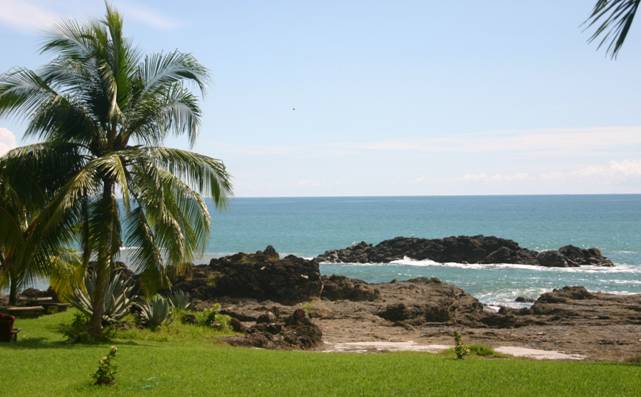
Malpais and Montezuma are only about 30 minutes apart with the crossroads at Cóbano (stop here for gas, groceries, and an ATM) in between. The easiest ways to get to either are by air from San José to Tambor or by water via the car ferry from Puntarenas to Paquera. There's also a water taxi from Jacó to Montezuma. If you're set on driving here overland, make sure you have a strong 4-WD and be prepared for some adventure. The only "all-season" road is basically a jeep trail over the mountains from Playa Naranjo to Paquera, with plenty of rocks, deep ruts, steep climbs, and stream crossings during the rainy season. You can also drive down the coast from Sámara to Malpais on Costa Rica 160, but only in the dry season and then only if no freak rainstorms have set the rivers running. Ask about conditions on both ends of this road before starting out!

Update (February, 2008): The road from the Paquera ferry terminal to Cóbano has been repaved and enormously improved - it's now a pleasant drive of less than 2 hours. The road from Cóbano on to Malpais has been widened and, if anything, made worse - it's now one of the worst dust-bowls in the country, and the constant heavy truck traffic can reduce visibility almost to zero. Wear a bandana on this stretch, even inside your car.
Update (March, 2009): The Cóbano - Montezuma road is in much better shape, and the route from Cabuya to Malpais - previously suitable mainly for horses - is now passable by car. The Cóbano - Playa Carmen road is good except for the final descent into Playa Carmen.
The Place ($-$$)
Malpais
Keywords: Surfing, Happening Place, Downtown

Photo © The Place
Contact Information:
506-2640-0001 (voice); 506-2640-0234 (fax)
info@theplacemalpais.com
www.theplacemalpais.com
Essentials:
3 Rooms, 5 Bungalows, One 2-BR Villa
English, Spanish, French, German
All major credit cards accepted
Off-street parking
Swimming pool, Beach access
Breakfast available, Bar
Room Amenities: Ceiling fan, Villa has full kitchen
How to get here:
Follow Highway 160 from Cóbano to Playa Carmen (the intersection
of road from Cóbano with the coast road, where Highway 160 turns
north). The Place is just south of this intersection, on the left.
We're not surfers, but the beaches north of Cabo Blanco also offer acres of tide pools, some broad and deep enough for swimming and all teeming with fish, crabs, and shelled creatures of all kinds. The rock is black so on sunny days the water trapped here at low tide quickly heats to warm-bath temperatures. If it has rained recently, countless little fresh-water streams sheet down the broad beaches, or emerge unexpectedly from the sand and race to the sea. Ospreys and herons fish the pools. Some of the rock is soft and worn smooth and slick by the constant bashing of the ocean; in other places it is hard and razor-sharp. Good river sandals are a must. All of this was once ocean bottom, and if the angle is right you can read thousands of layers of history in the ragged broken edges. Here and there massive monoliths tower several stories above the surf, last holdouts of what must once have been formidable seaside cliffs. You can walk for miles to the north, but the Cabo Blanco reserve itself can only be entered legally from the other side by Cabuya.
We spent the night at The Place in one of their comfortable wooden bungalows shaped like big, square, center-pole tents. The walls are mostly louvered panels that open either as double doors or as windows to let in light and air. It was cool enough at night with two ceiling fans - and the nightly rain - that we were happy for the quilt. Each bungalow has a theme. Ours was Africa with lions, tigers, and giraffes on the bedspreads, ceramic masks for reading lights, and the skeleton of some ancient riparian creature as a rock mosaic in the poured-concrete floor. The Place offers five bungalows, three smaller rooms, and a two-bedroom, air-conditioned villa with a full kitchen and private parking.
Aside from the villa, the lodgings here do not have private outdoor spaces, but the public spaces are ample and pleasant. The green-tile swimming pool is big enough for a few lazy laps and has a broad shallow edge where you can sun like a crocodile, half in and half out of the water. There is an open-air living room with rattan couches, coffee tables, books and a TV. A small bar serves beer and tropical drinks and is clearly a local hang-out. A weekly "movie night" attracts both guests and locals. There is also a small shop where you can pick up a new swimsuit, a sarong, or a souvenir T-shirt.
You're not right on the beach at The Place, but it's only two blocks away by road and close enough to hear the surf at night. You'll also have to head down the road for lunch or dinner; The Place only serves breakfast. There are several little sodas for roasted chicken or fried fish within an easy walk and taxis a block away at the main intersection in Carmen if you want to go farther.
Milarepa ($$-$$$)
Santa Teresa
Keywords: Oceanfront, Relax/Get away
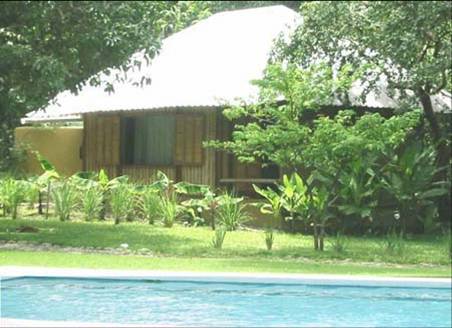
Photo © Milarepa
Contact Information:
506-2640-0023/2640-0663 (voice); 506-2640-0168 (fax)
reservations@milarepahotel.com
www.milarepahotel.com
Essentials:
4 Bungalows
English, Spanish
All major credit cards accepted
Off-street parking
Swimming pool
Breakfast included, Restaurant, Bar
Room Amenities: Ceiling fan, Refrigerator
How to get here:
Follow Highway 160 from Cóbano to Playa Carmen (the intersection
of road from Cóbano with the coast road, where Highway 160 turns
north). Milarepa is on the ocean (west) side of Highway 160, north of
Santa Teresa.
Legend has it that the notorious highwayman, Milarepa, achieved enlightenment and his true vocation of poetry while living in a cave on the high, snowy slopes of the Himalayas. The beachfront gardens here at Milarepa have never seen snow, but the ancient master would surely appreciate the constant rhythm of the waves with the raucous chattering of parrots as a counterpoint. And what a mighty voice the diminutive howler monkey has!
Milarepa was designed as a retreat with just four bamboo-walled bungalows, the open-air Soma restaurant, and a simple rectangular pool arranged on a gentle slope overlooking the beach. A Buddha stares placidly from Soma's center table down the long axis of the pool out to a black rock standing in the surf, well above high tide. The air of tranquility is palpable. The bungalows have clean lines and simple but elegant furnishings: a king bed, a mosquito net, a chest for your belongings. There are no phones, TVs, or other distractions. Just roll up the hanging bamboo curtains, welcome in the breezes, and let the surf wash out that space between your ears.
The downside to this degree of tranquility is that it seems to have spilled over into Milarepa's management and staff. They are hard to contact and seem to have little information or motivation to help you when you do contact them. This was disconcerting and we almost didn't include the hotel in the book, but the atmosphere is so lovely that we reconsidered.
A place this calm and intimate can, unfortunately, also be spoiled by obnoxious guests. As we waited for our lunch, a loud American shouted at her children to put on their shoes in case there were bugs. Bugs? There must be at least 1,000 ants for every square meter in this country, not to mention everything else! Had she somehow managed not to realize that she was taking her little boys to the tropics, and a pretty remote and hard to find part of the tropics at that? The manager rolled her eyes, and explained to us that these guests would be here for a week. We hope in that time they gained some kind of enlightenment, and that the kids took off their shoes, splashed around in the tide pools with the crabs, and lay on their bare bellies in the grass watching the bugs.
The lesson in all this, of course, is to gather some like-minded friends and reserve all four bungalows for yourselves. Then you can enjoy Jim, the chef's, garlic-papaya soup and splendid rare-seared tuna salad with those delightful little uchua berries in peace and quiet. I know, achieving enlightenment is supposed to be a challenge, but this is your vacation after all.
Flor Blanca ($$$$)
Santa Teresa
Keywords: Oceanfront, Honeymoons, Surfing, Spa,
Yoga/meditation, Destination Restaurant, Adults Only

Photo © Flor Blanca
Contact Information:506-2640-0232 (voice); 506-2640-0226 (fax)
florblanca@expressmail.net
www.florblanca.com
Essentials:
11 Bungalows
English, Spanish
All major credit cards accepted
Secure parking
Swimming pool, Spa
Breakfast included, Restaurant, Bar
Room Amenities: AC (Bedroom), Ceiling fan, Refrigerator/minibar, In-room safe,
Coffee maker, Free WiFi, Bathtub
How to get here:
Follow Highway 160 from Cóbano to Playa Carmen (the intersection
of the road from Cóbano with the coast road, where Highway 160
turns north). Flor Blanca is on the ocean (west) side of Highway 160,
north of Santa Teresa (just past Milarepa).
We spent an hour or so at the bar trading international-living stories with Susan and Greg who designed and built this place in 2002 and manage every aspect of its operation today; then we sat down to dinner. By course number four - a tiny cup of the richest, most explosively-flavored truffled mushroom soup we had ever experienced - we were beginning to understand why Flor Blanca's Nectar Restaurant is so well-regarded. Then came the grilled salmon, followed by a palate-cleansing sorbet of mango and Grey Goose. We finished with Dijon lamb chops and an utterly exquisite chocolate soufflé. It wasn't until after dinner that we learned just how lucky we'd been: Chef Demian Geneau was leaving the next morning to judge an international chef's competition in Madrid. Welcome to World Class.
A destination restaurant. Miles of stunningly-pristine coral-sand beach. A consistent three-meter-plus reef break right off shore. These are only the beginning of what Flor Blanca has to offer. Then there's your "room" - a tropical-contemporary house with fully open-air living room, perfectly-appointed master bedroom, and deliciously luxurious outdoor bathroom. Everything here reflects Susan's masterful design for luxury. Perfect lighting is one example, as is the absolutely-silent ceiling fan inside the romantic mosquito netting over the bed and the two-foot-diameter hand-punched copper shower head that dumps a monsoon of hot water over your head. Our guidebooks said Flor Blanca is the best beachside resort in Costa Rica and we'd felt our expectations rising with every axle-deep, rain-filled pothole we'd lurched through getting here. But we can tell you now: the guidebooks are right. This is it.
Alison chose a massage with Stefano (divine!) and yoga with Nancy (awesome!). I just poked around in the tide pools, roamed the beach, and sat in the shade listening to the surf break. And we talked with everybody. The Flor Blanca staff feels like an extended family; many of them have been here since opening day. The same guests return year after year, often staying for weeks at a time. Everyone is on a first-name basis. Susan explains that when something needs to happen here, it simply does, often in a surprising or quirky way. She, Nancy, and Greg are designing a new place now - Villa Samadhi - that will focus more on yoga and meditation. We'll be getting our reservations in early. Maybe today.
Tell the kid to get a job and go ahead and raid that college fund to spend a few weeks here at Flor Blanca. Greg will even send a pilot to pick you up at the airport in San José. Ride the monster breakers or just soak up the sun, the splendidly laid-back ambience, and the fabulous food. It'll be hard to call anyplace else "luxury" once you do.
Update (August, 2008): We hear that Susan and Greg have moved on to their own projects, so Flor Blanca has new managers.

Update (March, 2009): Flor Blanca has added a spa, an internet facility and an ultra-deluxe, two-story beachfront honeymoon villa. Demian Geneau started an oyster farm and a fish market/restaurant in Playa Carmen, but dinner at Flor Blanca's restaurant is still a treat. Yoga is still offered every morning. Best of all, the villas are still open-air, with optional air conditioning in the bedrooms.
Los Mangos ($-$$)
Montezuma
Keywords: Yoga/meditation, Downtown
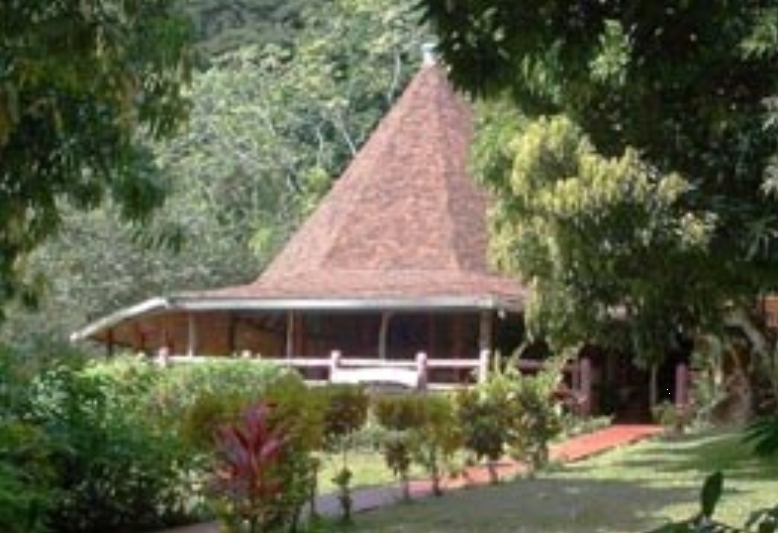
Photo © Los Mangos
Contact Information:506-2642-0076 (voice); 506-2642-0259 (fax)
homangos@racsa.co.cr
www.hotellosmangos.com
Essentials:
10 Rooms, 9 Bungalows
English, Spanish, German, Greek
All major credit cards accepted
Secure parking
Swimming pool, Beach access
Restaurants nearby
Room Amenities: Ceiling fan, Refrigerator/minibar (Bungalows only),
Semi-private outdoor space (Bungalows only)
How to get here:
In Cóbano, turn southeast (left if coming from Paquera) at the main
intersection toward Montezuma. Follow this road through
Montezuma toward Cabuya. Los Mangos is on the right side of the
road, just before the bridge.
Peaked black witch's hats poke out among the trees - the conical roofs of Los Mangos' nine bungalows. The owner, Costas, is from Athens, but the bungalows look more Black Forest than Greek with their deep porches, dark-stained wood, and cozy interiors. You half expect to see curious people with long beards and bright red hats speaking a language that sounds like the whistling of birds. Turn around, though, and you're looking straight south through the trees and flowers of the garden to the lazy surf below. These porches have hammocks - nothing particularly Germanic about that. Relax, this is Costa Rica after all, and you're a five-minute walk from the middle of Montezuma, surely one of the most laid-back places on earth.
Patin the cat - the name means "ice skate" and he appears everywhere, without obviously crossing the ground in between - accompanies us up to the rock-bordered, free-form swimming pool and the circular yoga studio above. Los Mangos is famous mainly for yoga. The ocean-view restaurant became a yoga studio years ago, and Dagmar Spremberg offers classes every morning. With its hibiscus blossoms and ocean view, it's hard to imagine a more pleasant setting. Dagmar specializes in week-long retreats and is booked months in advance with groups and guest instructors coming from California, New Mexico, New York, and other wellness-conscious places. Everyone in Montezuma seems to come here too, so you'll meet plenty of locals with your morning stretches.
Los Mangos offers ten rooms in addition to its bungalows, six with three beds and private baths and four even less expensive with shared baths. The upstairs rooms have a shared balcony with an ocean view, but all the rooms are close to the road and hence can be noisy. The bungalows are still reasonably priced and are very nice, well-appointed, and quite private. Up here in the trees, you mainly hear the birds with the surf providing a backbeat at high tide. Unless you're really strapped for cash, we definitely recommend springing for a bungalow.
There's no restaurant here, but breakfast is served at the soda right across the street. For dinner, one of the best places on the Pacific coast - Les Artistes - is practically next door. The menu is tropical Italian and the tables are set in the garden overlooking the surf below.
Update (January, 2008): Playa de les Artistes seems to be falling off a bit; our dinners there were good but not stellar, and the prices at les Artistes demand stellar. Dagmar's yoga class was great - check her out at www.montezumayoga.com.
Amor de Mar ($-$$)
Montezuma
Keyword: Oceanfront
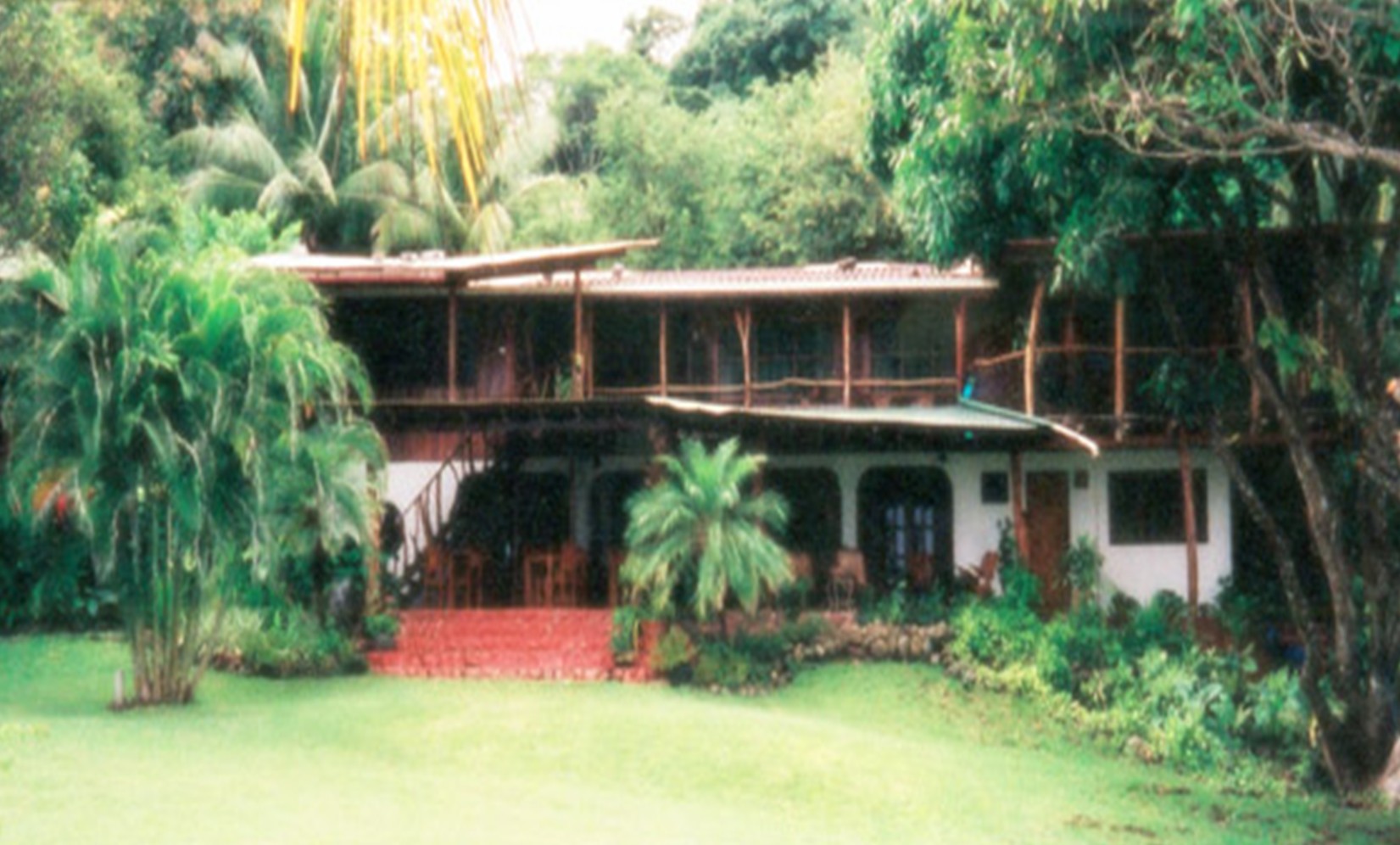
Photo © Amor de Mar
Contact Information:
506-2642-0262 (voice/fax)
shoebox@racsa.co.cr
www.amordemar.com
Essentials:
10 Rooms, 2 Houses
English, Spanish, German
All major credit cards accepted
On-street parking
Breakfast available, Restaurants nearby
Room Amenities: Floor fan, AC (#7 only), Houses have full kitchens.
How to get here:
In Cóbano, turn southeast (left if coming from Paquera) at the main
intersection toward Montezuma. Follow this road through
Montezuma toward Cabuya. Amor de Mar is on the ocean (left) side
of the road from Montezuma to Cabuya, just after the bridge. Park in
front.
All night long we heard the waterfall, even louder than the sea. At dawn we walked up the short trail to the first of the falls, a broad expanse of rain-muddied water tumbling over several meters of irregular boulders. The rocks were too slick to go farther upriver where the higher, more dramatic falls are. Besides, we were ready for coffee and breakfast.
The Amor de Mar was a tumble-down hostel when the owners, Richard and Ori, moved there with their family from Santa Fe, New Mexico in 1991 and set to work turning it into a sort-of European, sort-of California style B&B. The first thing you notice is the lawn - in fact you can see it as you cross the bridge from Montezuma - a rich green expanse running down to the black rocks and the water. It sprouts big wooden lawn chairs and a forest of hammocks. Everyone not out on the lawn is lounging under the big portal studying their birding charts, puzzling over the road map, or just napping. We hit the hammocks and listened to the waves on the incoming tide.
Most of the room numbers at Amor de Mar are changing as Ori converts the last two rooms that shared a bath into one big room with its own bath. After the renovation, the biggest room will be #4 upstairs with a grand view of the sea from a wall of windows. Our favorite is #9 (will be #8) downstairs on the corner over the river. The rooms are comfortably furnished with pristine white bedspreads and whimsical art and have excellent lighting and storage space. Avoid the rooms that back onto the road; guests in these complained of road noise. One surprising down-side to Amor de Mar was the constant drone of the portable television set the guard watched most of the afternoon. (Shouldn't he be walking around guarding?) Fortunately, there are plenty of outdoor spaces to get away from this annoyance.
The real gems at Amor de Mar are the two houses that Ori and Richard built, first for themselves and then for their children. These are fantasies of wood, glass, Santa Fe style plasterwork, and natural light. The big house has three bedrooms and a full kitchen downstairs and a huge circular bedroom with a domed roof, all-around windows, and vines climbing down the center-pole upstairs. A wrap-around upstairs deck looks over the lawn and the rocks below. The smaller house has a big kitchen and open sitting room downstairs and a grand master suite upstairs. The houses connect so a large group can use both - a real house party.
Amor de Mar has its own tide pool for lounging or even - we didn't try this - diving into. It's meters deep and refilled twice a day at high tide. The rocks are home to pelicans and thousands of crabs. Herons and kingfishers patrol the river mouth. You swing in your hammock, taking it all in. Aaahhh.
Update (January, 2008): The guard with the loud TV has moved on, thankfully. The falls are splendid, but erosion on the riverbank has made getting to them a challenge.
Hotel Celaje ($$)
Between Montezuma and Cabuya
Keyword: Oceanfront

Photo © Hotel Celaje
Contact Information:506-2642-0374 (voice/fax)
celaje@racsa.co.cr
www.celaje.com
Essentials:
7 Cabins
English, Spanish
Visa, MasterCard accepted
Secure parking
Swimming pool
Breakfast included, Restaurant, Bar
Room Amenities: Ceiling fan
How to get here:
In Cóbano, turn southeast (left if coming from Paquera) at the main
intersection toward Montezuma. Follow this road through
Montezuma toward Cabuya. Hotel Celaje is on the ocean (left) side
of the road coming from Montezuma toward Cabuya, about one km
before Cabuya.
We would never have found the Hotel Celaje, but we were poking up the dirt road to Cabuya looking for La Floresta, the studio of artist Claudia Bassauer. Claudia makes colorful paper lamps that decorate many of the hotels and restaurants and, we suspect, a lot of the private homes in and around Montezuma. Her partner, Daniel, carves stone and concrete into animals, flowers, and Escheresque abstractions.
Hotel Celaje offers seven two-story, A-frame cabins with thatched roofs and chalet-style wooden interiors. Each has a bedroom upstairs and a bathroom, storage space, and patio downstairs (kind of dangerous for those of us who get up in the middle of the night to go to the bathroom, but oh well). The bedrooms have a double and a single bed, a big window looking onto the garden and, since there's nothing else up here, plenty of room. The cabins are arranged in a wide arc around a free-form swimming pool and a little stream that runs down to the beach. Tall coconut palms stand all around. The hills that crowd down to the beach around Montezuma have receded a kilometer or more inland here, and the land is flat and lazy. Crested jays forage in the trees, but other than that the air is still.
You're right on the beach at Hotel Celaje, and it's a very different beach from Montezuma's: broad and flat with mounds of driftwood brought in by the currents eddying below Cabo Blanco. Streams pour out between the beachfront palms onto beds of well-polished rocks. Here and there a well-used little boat is drawn up on the sand. Just to your right is rocky, tree-covered Isla Cabuya with a graceful arch marking the entrance to the town cemetary. You can walk over to this gentle resting place at low tide. A bit down the road toward Montezuma is another wonder - the most enormous matapalo (strangler fig) we've ever seen, its tangled trunks spreading a good nine meters along the road and about five meters the other way, enclosing an area the size of a small house.
Hotel Celaje is owned by Belgians and you can enjoy Leffe and Stella Artois beers at the bar under the tall thatched A-frame roof of the restaurant. The menu mixes Costa Rican standards with a variety of pastas and crepes, and there are good Italian wines. Someone has painted beach scenes and marine critters on big swathes of raw burlap above the bar, an interesting counterpoint to the red tile floor and high, high - three stories, maybe four - peak of the roof. There's something a bit 19thcentury about this mix of tropical and European styles, as if the two cultures had just touched and hadn't yet had time to mix. This isn't tourist Costa Rica; you're on the very edge of civilization here.
Update (February, 2009): A recent report from Hotel Celaje was not good. If you stay there, let us know what you think at feedback@sleepingwiththetoucans.com.
Finca Los Caballos ($$)
Between Cóbano and Montezuma
Keywords: Hiking, Horseback riding
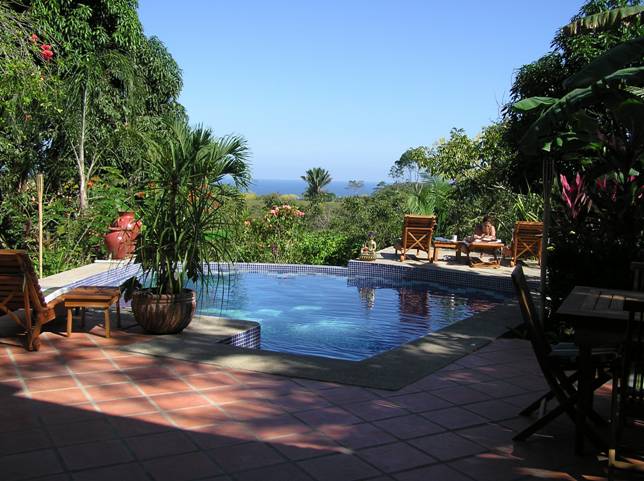
Photo © Finca Los Caballos
Contact Information:506-2642-0124 (voice); 506-2642-0664 (fax)
naturelc@racsa.co.cr
www.naturelodge.net
Essentials:
12 Rooms
English, Spanish, German
All major credit cards accepted
Secure parking
Swimming pool
Breakfast included, Restaurant, Bar
Room Amenities: Ceiling fan, Refrigerator/minibar (Pacific rooms),
Coffee maker (Pacific rooms), Private outdoor space
How to get here:
In Cóbano, turn southeast (left if coming from Paquera) at the main
intersection toward Montezuma. The finca is on the left side of the
road coming from Cóbano toward Montezuma, four km from
Cóbano. Look for the "Finca Los Caballos" sign, then follow the dirt
driveway up the hill.
You guessed it - this is a horse farm. There they are, at least twenty caballos of every size and color milling around as you drive into the property. No wonder everyone in and around Montezuma - at least the natives - seems to be on a horse! In this rugged countryside, they make a lot more sense than a car as transport.
Finca Los Caballos is up on the ridge about 200 meters above the Pacific. A rustic trail runs from the finca down to a little river then follows the river to the beach. There are waterfalls and, if there's been rain, fresh pools for a dip. It's about a three-hour walk on foot to the beach (you can get a cab back) and only a bit shorter on horseback. Once by the ocean you can go for miles, depending on the tide. If waterfalls and the beach don't appeal, you can head west over the rolling hills of the farm itself into the woods and fields of inland southern Nicoya. This is ranching country . . . high and open. A different world from the beach.
New owners, Christian and Luis, have transformed Finca Los Caballos from a resort devoted primarily to riding into a more upscale retreat and nature lodge. They have added four new "superior Pacific" rooms with private balconies overlooking the beach. These rooms have more amenities and visually-private balconies or patios so they're perfect for couples. If you're staying in a Pacific room, you can have dinner delivered and dine in privacy.
The refurbished restaurant offers tropical-continental fusion cuisine served on an open-air dining area with beautiful views over the canyons. The menu favors German touches and changes daily. After dinner, this space is transformed into an intimate and comfortable poolside bar, softly lit with a big view of the sky. There is art everywhere (most of it local) from the carved stone bancos featuring horses, devils, and sea creatures to the fanciful lighting and original paintings in the guestrooms.
Finca Los Caballos faces east, so the sun rises over the Gulf of Nicoya to greet you - a surprise on the Pacific coast. On a clear day, you can see across to Punta Conejos and the mountains above Jacó and watch the hawks circling in the sky. Montezuma and the beach are right below you but, sitting up here, they seem miles away.
Update (January, 2008): Dinner at Finca Los Cabalos was a tasty made-to-order mixed grill with a generous buffet of vegetables and salads. Usch is now offering massage, bodywork, and spa services on-site; make a reservation in advance.
Ylang-Ylang Beach Resort ($$$-$$$$)
Montezuma
Keywords: Oceanfront, Honeymoons, Art/Architecture
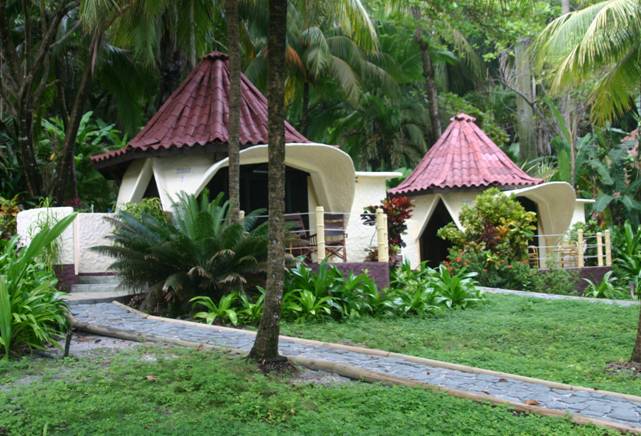
Photo © Alison Tinsley
Contact Information:
506-2642-0636 (voice); 506-2642-0068 (fax)
reservations@elbanano.com
www.ylangylangresort.com
Essentials:
6 Rooms, 8 Domes, 6 Tents with platforms
English, Spanish, Dutch
All major credit cards accepted
Secure parking
Swimming pool
Breakfast and dinner included, Restaurant, Bar
Room Amenities: Coffee maker, Refrigerator/minibar, In-room safe,
Ceiling fan, Free WiFi (restaurant area)
How to get here:
In Cóbano, turn southeast (left if coming from Paquera) at the main
intersection toward Montezuma. Once in Montezuma, turn left at
the main intersection, park across the street from the Sano Banano
restaurant, and ask the receptionist to call Ylang Ylang. They will
send a car to drive you and your luggage across the beach to Ylang
Ylang.
I awoke in the middle of the night to thundering surf. Thinking the water must be right up to our doorstep, I folded back the louvered door onto our dome's covered patio to check. The incoming tide crashed against the rocks below, right where it should be. It took me a minute to figure it out - our round dome with its arched roof flaring out over the patio was like a giant hand cupped to our ears to amplify the sound of the water. The surf sounded much louder inside than out. Satisfied that no tidal wave was imminent, I went back to sleep. Alison never even noticed.
Ylang Ylang's eight concrete-shelled domes are an innovative approach to beach accommodations and give the place an early1970's, Whole-Earth-Catalog kind of feel. Nestled as they are into the jungle, the red-roofed white domes with their triangular doors and windows look almost like odd growths, or some kind of alien conveyance. Inside, they're roomy and comfortable with king beds, good lighting, plenty of storage space, and outdoor showers (except #2, where everything's inside). Buckminster Fuller would be proud.
Aside from the domes, Ylang Ylang offers six conventional rooms with private baths and six tents on wooden platforms all sharing a single bathhouse. For those on a tighter budget, there are 11 rooms at the Sano Banano restaurant and hotel in downtown Montezuma with full use of the grounds and facilities at Ylang Ylang included in the price. But the prime spots here are the five domes right down by the little half-moon beach with its off-shore rocks to break up the surf and numerous shaded hammocks for lounging in the dappled sun.
The landscape at Ylang Ylang typifies the southeastern Nicoya coast: steep terrain, dense jungle, little protected beaches and lots of hard volcanic rock jutting out into the sea. A 20-minute walk to the east crosses red, green, straw-yellow, and black rock with deep crevasses sloshing with water and innumerable tide pools. At the next small cove, on the border of the Nicolas Wessberg Absolute Reserve, fanciful river-rock cairns and a brass plaque mark the resting place of Nicolas Wessberg and Karen Mogensen, pioneer conservationists of southern Nicoya. Walk even farther and you have another beautiful beach with no road access, secluded and quiet except for the birds and the surf.
Ylang Ylang is in Montezuma, but seems no longer of it. There's a hint of exclusivity, and some locals express open resentment about Ylang Ylang's Land Rovers driving over the town beach. But once you're here, there's no reason to leave. We can see why Ylang Ylang is popular for weddings, honeymoons, and yoga retreats: it is its own little world, close but far away. It's too bad you have to take that Land Rover when you leave and can't just slip away unseen as if you'd never had to touch down in the regular world at all.
Update (January, 2008): Ylang-Ylang may have come to some accomodation with the town; the Land Rover runs are less frequent. If you're coming for lunch, plan to walk the half-mile to Ylang-Ylang and get a ride back to town, as guests checking in have priority on the from-town runs.
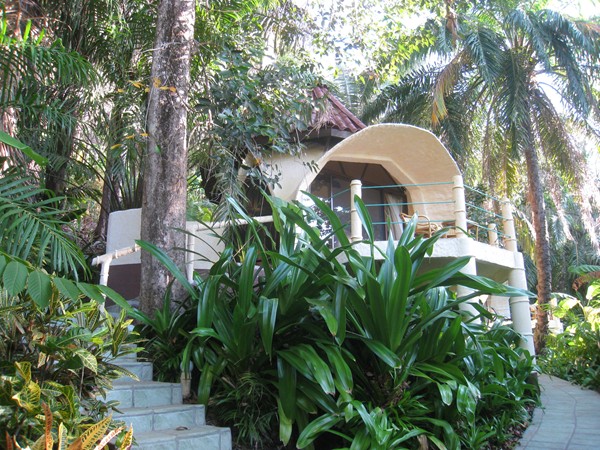
Update (March, 2009): Ylang-Ylang has added a new spa and retro-fitted all of the domes with air conditioning and new sliding glass doors. The new doors have screens, so you can still let natural air in at night. Yoga classes are now offered daily; we had a great class with Cali. Ylang-Ylang's restaurant is still our hands-down favorite in the Montezuma area, especially for lunchtime sushi.
We got the scoop on the Land Rovers. Ylang-Ylang has a special permit to use the beach for access. They only make a few trips per day. They take good care of the beach, too, including a massive clean-up effort following last fall's Pacific hurricane.
Under Consideration for the 100 Best in the 2010 Edition
Ylang-Ylang Lodge, Playa Manzanillo ($$-$$$)
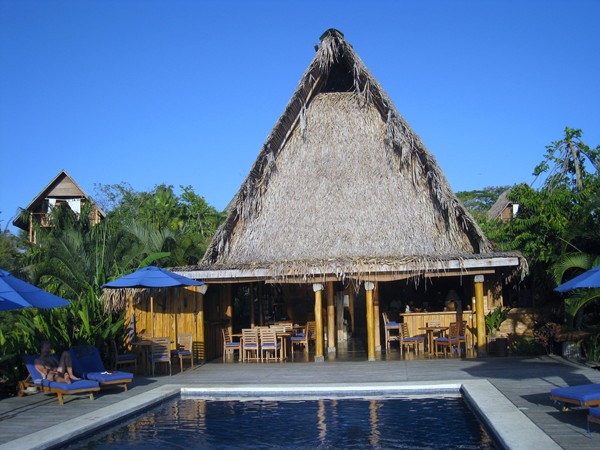
A few kilometers north of Playa Santa Teresa, the beachfront developments are behind you and you're back in the Costa Rica of expansive, empty beaches, occasional fishing boats and sleepy little towns. Playa Manzanillo is one of them - miles of beautiful beach, a couple of restaurants and a soccer field. Ylang-Ylang Lodge is a little piece of France in this idyllic countryside. Olivier the owner has visited well over a hundred countries, and chose this spot to call home.
Ylang-Ylang Lodge offers six bungalows, each two-story with the bedroom and a shaded deck upstairs to take full advantage of the continuous breeze between the mountains and the sea. The spacious pool-side rancho is decorated with Olivier's fanciful driftwood artworks, including an enormous mobile of planetary orbits filling the peak of the thatched roof. Miró meets Calder in the back of beyond. The beach is a 15 minute walk away. Perfect for a sea-side yoga retreat.
Jasmin the chef prepared whole sea bass steamed in herbs for dinner. We spoke French with our fellow guests. Olivier must have 200 different movies here on DVD, if you care for after-dinner entertinment. We're thinking of coming back for a week.
The easiest way to get to Manzanillo is via Cóbano. Go through Cóbano on the road to Playa Carmen and Malpais, then turn right (inland) a couple of kilometers south of town at the signs for Rio Negro and Betel. Just before Betel, a turn to the left is signposted to Playa Manzanillo. You'll need 4WD. Even this route may be impassable in the rainy season.
Reviewed March 12, 2009